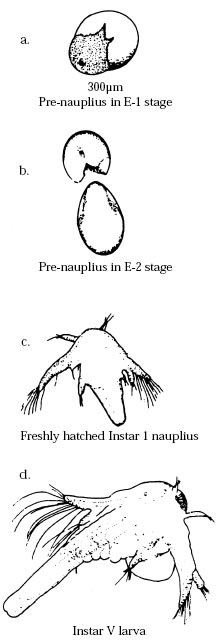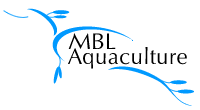Home > Downloads > Articles > Artemia Production for Marine Larval Fish Culture
Artemia Production for Marine Larval Fish Culture
October 2000
Southern
Regional
Aquaculture
Center
Granvil D. Treece1
Read the full article at Southern Regional Aquaculture Center site.
The brine shrimp (Artemia) is in the phylum Arthropoda, class Crustacea. Artemia are zooplankton, like copepods and Daphnia, which are used as live food in the aquarium trade and for marine finfish and crustacean larval culture. There are more than 50 geographical strains of Artemia. Many commercial harvesters and distributors sell brands of various qualities. Approximately 90 percent of the world's commercial harvest of brine shrimp cysts (the dormant stage) comes from the Great Salt Lake in Utah. However, the lake's cyst production is heavily influenced by freshwater inflow, and the supply varies dramatically. The cost of good quality cysts fluctuates with supply and demand; buyers might expect to pay $12 to $40 or more per pound (1/2 kg). Normally 200,000 to 300,000 nauplii might hatch from each gram of high quality cysts. This publication describes the process of hatching Artemia cysts for use as larval food for cultured species, and the benefits of Artemia as a food source.
Background
Artemia are extremely euryhaline, withstanding salinities from 3 ppt to 300 ppt. They can even survive short periods of time in freshwater, but cannot reproduce in it. Artemia survive temperatures ranging from 15 to 55 oC (59 to 131 oF). They have two modes of reproduction. Sometimes nauplii (first Artemia swimming stage) hatch in the ovisac of the mother and are born live. However, when the body of water where adult Artemia are living begins to dry up and salinities rise, embryos are encased in a hard capsule, or cyst, so that they are protected and can hatch later when conditions are better. The cyst is 200 to 300 micrometers in diameter, depending upon the strain. Its external layer is a hard, dark brown shell. Dry conditions cause the encysted embryo to enter a dormant state, which allows it to withstand complete drying, temperatures over 100 oC (212 oF) or near absolute zero, high energy radiation, and a variety of organic solvents. The dehydrated cyst can be stored for months or years without loss of hatchability. Only water and oxygen are required to initiate the normal development of the Artemia embryo, but it does help the hatch rate to maintain the temperature above 25 oC (77 oF) and place a light near the eggs. The durable, easily hatched cyst makes Artemia a convenient, constantly accessible source of live feed for the finfish hatchery operator. Artemia cysts are best stored in a tightly sealed container in a cool, dry environment and, if possible, vacuum packed.
 Within 15 to 20 hours after being
placed in seawater at 28 oC (82
oF), the shell breaks and the prenauplius
in E-1 stage appears
(Fig. 1a). For the first few hours,
the embryo hangs beneath the
cyst shell in what is called the
umbrella stage. The newly
hatched Artemia relies on its yolk
sac for nutrients because its
mouth and anus are not fully
developed. The pre-nauplius E-2
stage (Fig. 1b) is then released as a
free-swimming nauplius (Fig. 1c)
called an Instar 1 nauplius. In this
stage it is brownish orange because
of its yolk reserves. It uses
specially modified antennae for
locomotion and later for food filtering.
Approximately 12 hours
after hatch it molts into the second
larval stage (Instar II) and starts
filter feeding on microalgae, bacteria
and detritus. The Artemia nauplius
can live on yolk and stored
re-serves for up to 5 days or
through the Instar V stage (Fig.
1d), but its caloric and protein
content diminish during this time. The nauplius progresses through
15 molts before reaching adulthood
in approximately 8 days.
Within 15 to 20 hours after being
placed in seawater at 28 oC (82
oF), the shell breaks and the prenauplius
in E-1 stage appears
(Fig. 1a). For the first few hours,
the embryo hangs beneath the
cyst shell in what is called the
umbrella stage. The newly
hatched Artemia relies on its yolk
sac for nutrients because its
mouth and anus are not fully
developed. The pre-nauplius E-2
stage (Fig. 1b) is then released as a
free-swimming nauplius (Fig. 1c)
called an Instar 1 nauplius. In this
stage it is brownish orange because
of its yolk reserves. It uses
specially modified antennae for
locomotion and later for food filtering.
Approximately 12 hours
after hatch it molts into the second
larval stage (Instar II) and starts
filter feeding on microalgae, bacteria
and detritus. The Artemia nauplius
can live on yolk and stored
re-serves for up to 5 days or
through the Instar V stage (Fig.
1d), but its caloric and protein
content diminish during this time. The nauplius progresses through
15 molts before reaching adulthood
in approximately 8 days.
The goal of the hatchery manager is to use the Artemia as feed as soon as possible after they hatch because that is when they are most nutritious. However, the lipid level and fatty acid composition of newly hatched Artemia nauplii can be highly variable, depending upon the strain and year class. Many researchers have studied the levels of highly unsaturated fatty acids (HUFA) in Artemia. Most of these studies indicate that the performance of larval fish is directly related to the level of HUFA in Artemia being fed and that essential fatty acids are the principal food value of Artemia. When Artemia contain low levels of HUFA, the survival of larval fish declines.
The type of food consumed by the parent Artemia greatly influences the fatty acid content of the cysts. Artemia composition is generally in the range of 51 to 55 percent protein, 14 to 15 percent carbohydrate, 13 to 19 percent fat, and 3 to 15 percent n-3 HUFA. When analyzed on a dry weight basis, cysts of one well-known brand of Artemia contained 28 percent crude protein, 10 percent crude fiber and 10 percent crude fat. To compensate for a poor HUFA level in Artemia, they can be enriched with omega yeast, vitamins (E, D, C and B12), marine oils, vitamin B12-producing bacteria, and commercial enrichment media (Super Selio®, Algamac®, etc.).
It is important to feed Artemia nauplii to fish larvae as soon as possible after hatching to take full advantage of the yolk and stored reserves found in freshly hatched Instar I nauplii (Fig. 1c). If there is a delay in feeding Artemia, they may also become too fast and too large for the fish larvae to catch and eat. Also, freshly hatched nauplii are dark orange and much easier to see than older nauplii, which are transparent. Some strains of Artemia may be too large for the fish being cultured, so it would be wise to ask other hatchery managers for their suggestions about which strains to use. Figure 2 shows the size of a freshly hatched Artemia nauplius relative to a 12- to 13-day post-hatch red drum larva. Feeding an oversized Artemia strain can cause fish larvae to grow poorly or even starve.
Optimum conditions for hatching Artemia cysts
The optimal conditions for hatching Artemia are: 1) temperature above 25 oC (77 oF), with 28 oC (82 oF) being optimum; 2) salinity of 5 ppt (1.030 density); 3) heavy, continuous aeration; 4) constant illumination (example: two 40- watt fluorescent bulbs for a series of four 1-liter hatching cones); and 5) a pH of about 8. Stocking density is set by adding no more than 5 grams of cysts per liter of water. Good circulation is needed to keep the cysts in suspension. A container that is V-shaped or cone-shaped is best (2-liter bottles work well; glue a valve on the bottle cap and invert it). The best container is a separation column, found in any lab supply, although it is more expensive. Unhatched cysts, empty shells and hatched nauplii can be easily removed separately. The hatching percentage and density are usually a function of water quality, circulation, and the origin of the cysts.
Preparation and use of Artemia
There are seven tasks involved in feeding Artemia to larvae.
- Determine the weight of Artemia cysts required to feed the larvae in a tank of known volume.
- Hydrate and decapsulate cysts (decapsulation is optional, but recommended).
- Incubate cysts.
- Separate cysts from shells and debris (not necessary if cysts were decapsulated).
- Count the hatched Artemia.
- Calculate the number of Artemia remaining in the rearing tank from the previous feeding.
- Calculate the number of Artemia nauplii required by the larvae and transfer them to the rearing tank.
Be careful with step number 6, as remaining nauplii may have little nutritional value and may need to be flushed out of the system.
Details of each of the tasks will be discussed in the following smallscale example. Materials and equipment needed are:
- Artemia cysts
- two 250-ml (8.5-fluid ounce) beakers
- distilled water
- household bleach
- sodium hydroxide (NaOH)
- 1-liter Imhoff cone or settling column
- low-pressure air supply (aquarium pump)
- seawater or equivalent (salinity of 5 to 32 ppt)
- siphon tube (approximately 4 feet long) or a valve at the bottom of the cone
- 1-ml pipet
- 10-ml pipet
1. Determine the amount of Artemia cysts required
Artemia nauplii are maintained in the larval culture tank at densities of 0.5 to 2 per ml for most species of finfish and up to 6 per ml in the more advanced larval shrimp stages. To estimate the amount of Artemia required one must consider both the volume of the tank and the expected number of Artemia the larvae will consume. Based on the stage or the age of the larvae, estimate a daily Artemia requirement per ml. This feeding rate can be adjusted slightly, depending on the stocking density (number of target larvae per liter) and the rate at which the Artemia are consumed. The total requirement is then calculated by multiplying the predicted requirement per ml by the total volume of the rearing tanks. Each gram of cysts contains approximately 200,000 to 300,000 cysts. Artemia generally have at least a 50 percent hatch. Experience with your specific brand will allow you to adjust these figures.
Read the rest of the article at SRAC web site.
The work reported in this publication was supported in part by the Southern Regional Aquaculture Center through Grant No. 97-38500-4124 from
the United States Department of Agriculture, Cooperative States Research, Education, and Extension Service.
1Texas A&M University, Sea Grant College
Program

Exceptional Aquaculture
Reliable Results
4569 Samuel Street
Sarasota, FL 34233
v: 1-800-889-0384
f: (941) 922-3874
e: sales@mblaquaculture.com
www.mblaquaculture.com

